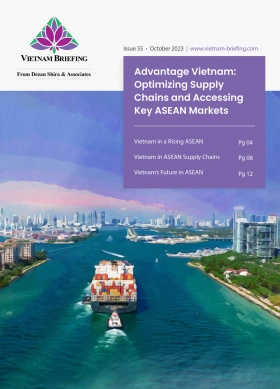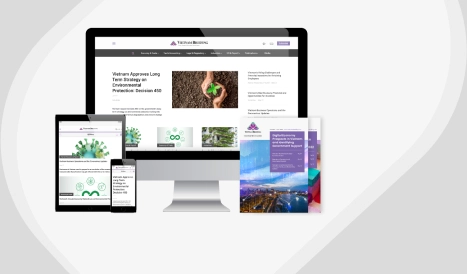Trade Relations Between Vietnam and Thailand
The leaders of Vietnam and Thailand met on the sidelines of the ASEAN-Japan summit last week to discuss ongoing trade relations between the two countries. Here’s what that trade looks like.
Prime Minister Chinh Minh Pham met with Thai Prime Minister Srettha Thavisin on the sidelines of the ASEAN-Japan Summit last week in Tokyo.
The two leaders discussed the progress of the Vietnam-Thailand strategic cooperation relationship and committed to a action plan developed with respect to the implementation of the Vietnam-Thailand Enhanced Strategic Partnership for 2022-2027.
The two leaders also said they wanted to bring bilateral trade to US$25 billion in trade turnover. In this respect, the Vietnam Briefing discusses where trade turnover between Vietnam and Thailand is currently at.
Trade rules and regulations between Thailand and Vietnam
Both active members of the Association of Southeast Asian Nations (ASEAN), the bulk of trade conducted between Vietnam and Thailand is governed by several intra-ASEAN free trade agreements.
ASEAN Free Trade Area Agreement (AFTA)
The ASEAN Free Trade Area Agreement (AFTA) is a multilateral free trade agreement among ASEAN countries. This agreement establishes the framework for gradually lowering tariffs to 0 to 5 percent and streamlining customs procedures between countries.
Regional Comprehensive Economic Partnership (RCEP)
The Regional Comprehensive Economic Partnership (RCEP) is aimed at strengthening ties between the ASEAN countries and Australia, New Zealand, China, Japan, and South Korea. It is one of the world’s biggest trading agreements with member states accounting for around 30 percent of global GDP.
The goal of the RCEP is to eliminate at least 92 percent of tariffs in signatory nations within the next 20 years. In parallel, RCEP is intended to save traders money and time by allowing them to export goods to any signatory country under a collectively developed set of standards.
RCEP benefits for Thailand-Vietnam trade
Trade between Vietnam and Thailand appears to have benefited from the RCEP since it formally took effect in Vietnam on January 1, 2022. Despite the fact that the global economy has been facing several challenges, export turnover between Thailand and Vietnam hit US$21.6 billion in 2022. Thailand remains Vietnam’s largest ASEAN economic partner and Vietnam is Thailand’s second-largest ASEAN trading partner and fifth-largest trading partner globally.
Double Taxation Avoidance
The Double Taxation Avoidance Agreement between Vietnam and Thailand was signed on December 23, 1992, to avoid double taxation. In addition, this agreement also creates a legal framework for the tax authorities of the two countries to prevent tax evasion on income and assets.
The Promotion and Protection of Investments
Vietnam and Thailand signed a mutual investment promotion and protection agreement on November 30, 1991. The signing of this agreement is intended to establish better conditions for greater economic cooperation between the two countries. Especially for capital investment by citizens and companies of one country into the other.
The agreement helps to increase investment initiatives in both countries. Specifically, point a clause 1 of Article 4 of the law, states that investors will be treated equally under the law.
Thailand FDI projects in Vietnam
Vietnam presently has 20 new projects with FDI from Thailand totaling US$394.95 as of July 2023. The majority of Thai projects in Vietnam are small to medium-sized. According to Praween Wirotpan, Chairman of the Thailand Chamber of Commerce, most of Thailand’s leading corporations have invested in Vietnam with projects in industries as varied as retail, petrochemicals, paper packaging, construction materials, animal and farm feed, and renewable energy.
Thailand’s exports to Vietnam
Thailand’s overall export value to Vietnam exceeded US$14 billion in 2022. Petroleum products; computers, electrical products, spare parts and components thereof; motor vehicles; parts and accessories of motor vehicles, and other products accounted for the bulk of these exports.
Thailand’s exports to Vietnam, 2022
| Description | Value (US$) |
| Fishery products | 49,032,675 |
| Milk and milk products | 60,598,882 |
| Fruits and vegetables | 49,703,226 |
| Maize (corn) | 18,772,232 |
| Animal, and vegetable fats and oils | 82,877,441 |
| Pastrycooks, sweets, and cereals products | 74,231,318 |
| Other edible food preparations | 84,657,203 |
| Animal fodders and animal fodder materials | 137,500,027 |
| Ores and other minerals product | 52,827,795 |
| Petroleum products | 1,158,324,686 |
| Liquefied petroleum gases (LPG) | 34,161,957 |
| Other petroleum products | 159,138,241 |
| Chemicals | 562,605,294 |
| Chemical products | 398,905,778 |
| Pharmaceutical materials | 1,995,754 |
| Pharmaceutical products | 112,486,312 |
| Fertilizers | 3,709,614 |
| Essential oils and resinoids; perfumery, cosmetic or toilet preparations | 144,328,943 |
| Insecticides, rodenticides, and materials | 41,574,935 |
| Plastics | 964,463,778 |
| Plastic products | 288,371,933 |
| Rubber | 126,269,861 |
| Rubber products | 95,197,732 |
| Wood and wooden products | 142,123,819 |
| Paper | 168,077,061 |
| Paper products | 65,625,862 |
| Yarn | 117,448,716 |
| Fabrics | 324,257,714 |
| Textile, leather, and foot-wear materials and auxiliaries | 326,257,714 |
| Glass and glassware | 60,899,789 |
| Precious stones, precious metals, and articles thereof | 45,277,154 |
| Iron and steel | 140,326,015 |
| Iron and steel products | 157,611,177 |
| Other base metals | 635,471,757 |
| Other base metal products | 57,936,423 |
| Computers, electrical products, spare parts, and components thereof | 1,700,425,698 |
| Electric consumer products and parts thereof | 808,848,976 |
| Still images, video cameras, and parts thereof | 30,985,116 |
| Machine, equipment, tools, and instruments | 1,039,893,229 |
| Insulated wires and cables | 72,093,206 |
| Motor vehicles | 1,429,926,259 |
| Parts and accessories of motor vehicles | 1,009,746,524 |
| Other products | 1,056,738,341 |
| Total | 14,092,413,963 |
Source: General Customs Department of Vietnam
Computers, electrical products, spare parts, and components thereof
Consumption of electronic gadgets is expanding in Vietnam. In this light, Thailand supplied computers, electrical products, spare parts, and components thereof to Vietnam worth more than US$1.7 billion in 2022.
Motor vehicles; Parts and accessories of motor vehicles
Thailand is currently the leading supplier of replacement parts and full vehicle items to Vietnam. IThis is partly attributable to a tax exemption policy which sees all cars of ASEAN origin (with a localization rate of 40 percent or more) imported into Vietnam tax-exempt until the end of 2027. As a result, by the end of 2022, Thailand had exported over US$1.43 billion for motor vehicles and more than US$1 billion of parts and accessories of motor vehicles to Vietnam.
Petroleum products
Despite the fact that Vietnam extracts and exports crude oil, it still has to import petroleum to meet local demand. Thailand has become one of Vietnam’s biggest sources of petroleum products due to its proximity and the relatively low trade barriers due to several free trade agreements.
Vietnam’s exports to Thailand
Vietnam’s exports to Thailand are just over half of Thailand’s exports to Vietnam coming in at US$7.5 billion. One explanation for this trade deficit is that Thailand’s biggest retail businesses have recently engaged in mergers and acquisitions with retail chains in Vietnam. This has given Thai goods easier access to Vietnamese consumers.
Central Retail Group, for example, is set to invest approximately US$1.45 billion in Vietnam over the next five years. Another example is Central Group, a firm owned by Thailand’s Chirathivat family, which purchased 49 percent of the shares in Nguyen Kim, a well-known electronics supermarket chain in Vietnam.
| Description | Value (US$) |
| Fishery products | 331,624,770 |
| Fruits and vegetables | 168,055,205 |
| Cashew nut | 48,602,272 |
| Coffee | 76,559,664 |
| Pepper | 26,135,719 |
| Pastrycooks, sweets, and cereals products | 24,333,184 |
| Animal fodders and animal fodder materials | 34,748,616 |
| Ores and other minerals product | 555,864 |
| Coal | 27,807,858 |
| Crude oil | 880,474,002 |
| Petroleum products | 2,453,046 |
| Chemicals | 49,305,736 |
| Chemical products | 182,765,759 |
| Fertilizers | 21,350,610 |
| Plastics | 100,047,765 |
| Plastic products | 96,850,820 |
| Rubber products | 19,990,797 |
| Handbags, purses, suit-cases, headgear and umbrellas | 9,092,692 |
| Wood and wooden products | 69,332,588 |
| Paper and paper products | 112,847,769 |
| Yarn | 124,252,236 |
| Textiles and garments | 239,343,297 |
| Tyre cord fabrics and other fabrics for technical uses | 40,461,101 |
| Foot-wears | 69,089,502 |
| Textile, leather, and foot-wear materials and auxiliaries | 40,702,548 |
| Ceramics products | 33,291,352 |
| Glass and glassware | 7,838,238 |
| Precious stones, precious metals, and articles thereof | 4,067,886 |
| Iron and steel | 281,786,939 |
| Iron and steel products | 103,813,662 |
| Other base metals and other base metal products | 369,144,668 |
| Computers, electrical products, spare parts, and components thereof | 524,212,948 |
| Telephones, mobile phones, and parts thereof | 1,007,541,745 |
| Machine, equipment, tools, and instruments | 964,820,116 |
| Insulated wires and cables | 108,032,951 |
| Other means of transportation, parts, and accessories thereof | 636,756,366 |
| Other products | 638,118,509 |
| Total | 7,476,208,801 |
Source: General Department of Customs
Crude oil
According to CEIC Data, Thailand is a country with a high demand for petrol with daily oil consumption exceeding 1.2 million barrels in 2022. It does, however, have limited oil reserves, accounting for less than 1 percent of the world’s total oil reserves, and therefore relies heavily on oil imports.
Vietnam–Thailand trade prospects
In recent years, commercial relations between Vietnam and Thailand have grown considerably. In 2022, when the global economy was experiencing a number of challenges, the two countries’ import-export turnover reached US$21.6 billion.
Thailand is Vietnam’s largest trading partner in ASEAN and one of the country’s biggest foreign investors. Vietnam, on the other hand, is Thailand’s second-largest trading partner in ASEAN and fifth in the globe. With this strong and mutually beneficial partnership, trade relations between the two countries are expected to grow and advance even further moving forward.
Thai investors can contact the experts at Dezan Shira and Associates for assistance and more extensive information about investing in Vietnam.
About Us
Vietnam Briefing is published by Asia Briefing, a subsidiary of Dezan Shira & Associates. We produce material for foreign investors throughout Eurasia, including ASEAN, China, India, Indonesia, Russia & the Silk Road. For editorial matters please contact us here and for a complimentary subscription to our products, please click here.
Dezan Shira & Associates provide business intelligence, due diligence, legal, tax and advisory services throughout the Vietnam and the Asian region. We maintain offices in Hanoi and Ho Chi Minh City, as well as throughout China, South-East Asia, India, and Russia. For assistance with investments into Vietnam please contact us at vietnam@dezshira.com or visit us at www.dezshira.com
- Previous Article Vietnam Set for 6 Percent Minimum Wage Hike in 2024
- Next Article Vietnam Updates Regulations on Pharmaceutical Product Labeling





